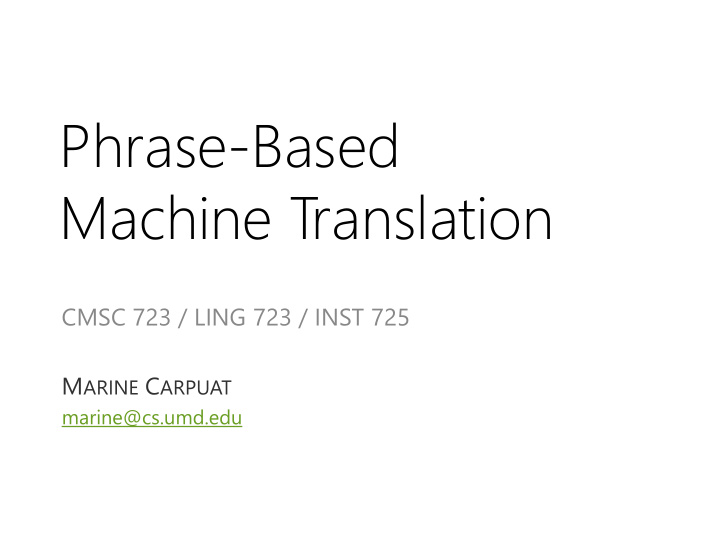



Phrase-Based Machine Translation CMSC 723 / LING 723 / INST 725 M ARINE C ARPUAT marine@cs.umd.edu
Noisy Channel Model for Machine Translation • The noisy channel model decomposes machine translation into two independent subproblems – Language modeling – Translation modeling / Alignment
Word Alignment with IBM Models 1, 2 • Probabilistic models with strong independence assumptions • Alignments are hidden variables – unlike words which are observed – require unsupervised learning (EM algorithm) • Word alignments often used as building blocks for more complex translation models – E.g., phrase-based machine translation
PH PHRAS ASE-BASED BASED MO MODE DELS
Phrase-based models • Most common way to model P(F|E) nowadays (instead of IBM models) Start position of f_i End position of f_(i-1) Probability of two consecutive English phrases being separated by a particular span in French
Phrase alignments are derived from word alignments This means that the IBM model represents P(Spanish|English) Get high confidence alignment links by intersecting IBM word alignments from both directions
Phrase alignments are derived from word alignments Improve recall by adding some links from the union of alignments
Phrase alignments are derived from word alignments Extract phrases that are consistent with word alignment
Phrase Translation Probabilities • Given such phrases we can get the required statistics for the model from
Phrase-based Machine Translation
DE DECOD ODING NG
Decoding for phrase-based MT • Basic idea – search the space of possible English translations in an efficient manner. – According to our model
Decoding as Search • Starting point: null state. No French content covered, no English included. • We’ll drive the search by – Choosing French word/phrases to “cover”, – Choosing a way to cover them • Subsequent choices are pasted left-to-right to previous choices. • Stop: when all input words are covered.
Decoding Maria no dio una bofetada a la bruja verde
Decoding Maria no dio una bofetada a la bruja verde Mary
Decoding Maria no dio una bofetada a la bruja verde Mary did not
Decoding Maria no dio una bofetada a la bruja verde Mary Did not slap
Decoding Maria no dio una bofetada a la bruja verde Mary Did not slap the
Decoding Maria no dio una bofetada a la bruja verde Mary Did not slap the green
Decoding Maria no dio una bofetada a la bruja verde Mary Did not slap the green witch
Decoding Maria no dio una bofetada a la bruja verde Mary did not slap the green witch
Decoding • In practice: we need to incrementally pursue a large number of paths. • Solution: heuristic search algorithm called “multi - stack beam search”
Space of possible English translations given phrase-based model
Stack decoding: a simplified view Note: here “stack” = priority queue
Thr hree ee st stage ages s of st f stack ack decoding ecoding
“ multi ulti-stack stack beam eam search” One stack per number of French words covered: so that we make apples-to-apples comparisons when pruning Beam-search pruning for each stack : prune high cost states (those “outside the beam”)
“multi - stack beam search”
Cost = current cost + future cost • Future cost = cost of translating remaining words in the French sentence • Exact future cost = minimum probability of all remaining translations – Too expensive to compute! • Approximation – Find sequence of English phrases that has the minimum product of language model and translation model costs
Recombination • Two distinct hypothesis paths might lead to the same translation hypotheses – Same number of source words translated – Same output words – Different scores • Recombination – Drop worse hypothesis
Recombination • Two distinct hypothesis paths might lead to hypotheses that are indistinguishable in subsequent search – Same number of source words translated – Same last 2 output words (assuming 3-gram LM) – Different scores • Recombination – Drop worse hypothesis
Complexity Analysis • Time complexity of decoding as described so far O(max stack size x sentence length^2) – O( max stack size x number of ways to expand hyps. x sentence length)
Reordering Constraints Idea: limit reordering to maximum reordering distance Typically: 5 to 8 words - Depending on language pair - Empirically: larger limit hurts translation quality Resulting complexity: O(max stack size x sentence length) – because we limit reordering distance, so that only a constant number of hypothesis expansions are considered
RECAP AP
Noisy Channel Model for Machine Translation • The noisy channel model decomposes machine translation into two independent subproblems – Language modeling – Translation modeling / Alignment
Phrase-Based Machine Translation • Phrase-translation dictionary
Phrase-Based Machine Translation • A simple model of translation – Phrase translation dictionary (“phrase - table”) • Extract all phrase pairs consistent with given alignment • Use relative frequency estimates for translation probabilities – Distortion model • Allows for reorderings
Decoding in Phrase-Based Machine Translation • Approach: Heuristic search • With several strategies to reduce the search space – Pruning – Recombination – Reordering constraints
What are the pros and cons of phrase-based vs. neural MT?
Recommend
More recommend